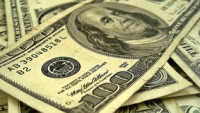 USD: Drop does not look too sustainable
USD: Drop does not look too sustainable
The dollar took a hit yesterday as US S&P Global PMIs came in weaker than expected. The composite index dropped to 50.9, with manufacturing moving back into contraction (49.9) and services slowing to 50.9. While these surveys aren’t as highly regarded as the ISM in the US, markets were probably surprised by the diverging patterns with eurozone PMIs. For the first time in 12 months, the eurozone composite PMI is higher than the US one. While the manufacturing picture remains much more clouded in the eurozone, the service sector appears to be in better shape.
All this is naturally in contrast with the notion of US growth exceptionalism. Tomorrow, we’ll see how much GDP growth has slowed in the first quarter. While activity indicators could prompt some FX moves, the kind of major repricing in Fed expectations that we saw in April can only be triggered by lower inflation, soft employment figures, or Fed communication. So, the major risk events for the dollar in the coming days are: PCE inflation on Friday, the Fed meeting on 1 May, and jobs data on 3 May. The Fed Funds futures curve continues to price in only 40bp of easing this year.
Even before US PMIs were released, the FX market was navigating a risk-on, dollar-off narrative. European equities have now had three consecutive good sessions, and US tech shares are finding some support. Markets are putting money to work in FX by favouring antipodeans (Aussie and New Zealand dollar) and scandies (Norway’s krone, Sweden’s krona) more than others in G10. These are the four high-beta currencies that have shown the clearest risk-on character, while the Canadian dollar should remain a laggard in risk rallies – especially when fuelled by softer US data.
The euro-heavy DXY index has slid below 106.0, but remains some 1.5% higher than the April lows (104.1). We may not get much excitement in dollar crosses until GDP and most importantly PCE figures are released later this week. The dollar may stay under some modest pressure for a bit longer, but resilient GDP and PCE could favour a return above 106.00 by the weekend.
EUR: PMIs not moving ECB pricing
For once, US-eurozone divergence in data has come to the benefit of EUR/USD, which is attempting consolidation at 1.0700 this morning. As noted above, hard data (inflation and employment above all) has been the real drag on the pair so far, so caution is warranted when it comes to rallies prompted by activity surveys like PMIs.
This morning, the German Ifo will be in focus, with consensus expecting an improvement across all three main surveys (business climate, current assessment and expectations). Good figures could cement more upbeat expectations on eurozone growth, although the chances that this materially impacts European Central Bank pricing are low.
Markets appear very comfortable with pricing for 75bp of easing by year-end, and ECB members appear to be converging around this view. Even the generally hawkish Joachim Nagel reiterated yesterday that it may be appropriate to cut rates as inflation declines. All this makes us reluctant to call for another leg higher in EUR/USD: the 2-year EUR:USD swap rate gap has tightened by a mere 5bp since the -160bp bottom, and continues to unequivocally point at a weaker EUR/USD. We have long discussed how resilient equities have played a role in keeping EUR/USD above its yield differential-implied short-term fair value, so a continuation of the positive risk sentiment environment appears necessary to keep EUR/USD above 1.0700.
GBP: Data and Pill fuel rebound
The pound rebounded by almost 1% versus the dollar yesterday, thanks to the combined effect of a weaker USD, supported risk sentiment, better-than-expected UK PMIs and some relatively hawkish comments by Bank of England Chief Economist Huw Pill.
Despite the manufacturing PMI survey dropping below 50.0 in April, the UK service sector showed good momentum (54.9), carrying the composite index to a one-year high. The broadly positive signals for growth have to be weighed, however, with data on the UK budget deficit exceeding expectations to an extra £12.4bn over the fiscal year. This inevitably curbs expectations of another tax-cutting event before the election and has a net negative impact on sterling over time as the risks to fiscal policy-led inflation fade.
Moving onto the Bank of England’s communication, markets have received further indications of how divided the MPC is at the moment. Yesterday, Chief Economist Huw Pill said there is a “reasonable way to go” before he is convinced that underlying price pressures have been tamed. As things stand now, it looks like at least four of nine MPC members are dissenting against the recent dovish rhetoric. The Sonia curve has reacted by pricing out around 5bp of cuts for the upcoming meetings. Still, an August 25bp decrease remains fully priced in. EUR/GBP is back below 0.8600 this morning, and we could see some stabilisation in the short term as both the UK calendar and BoE-speak go quiet.
AUD: Inflation surprise puts Aussie $ in good position
We have been calling for upside risks to the inflation picture in Australia, and are not surprised to see AUD rallying this morning after stronger-than-expected CPI figures. The 1Q print showed core measures of inflation staying above 4%, while the headline rate only decelerated to 3.6% year-on-year. The March CPI reading came in hotter than expected at 3.5% (cons. 3.4%).
Australia’s two-year swap rate jumped by around 15bp after the release, and at 4.51% is at the highest since November 2023. The AUD OIS curve priced out a cut before year-end, with only 8bp of easing left for the December meeting.
While the risks of another hike are not totally negligible, inflation figures were probably insufficient to warrant such a turnaround in policy. We think the Reserve Bank of Australia can achieve its inflation target without having to raise rates again, but may well need to digest some further bumps in inflation, which suggest further steps to the dovish side in communication will be taken with more caution.
All these developments are positive for AUD, which has jumped back above 0.6500. While still vulnerable to risk-off turns, the Australian dollar is one of those currencies that can benefit from delayed policy easing expectations domestically and one of those in a stronger position to stay supported in a stable risk environment.












